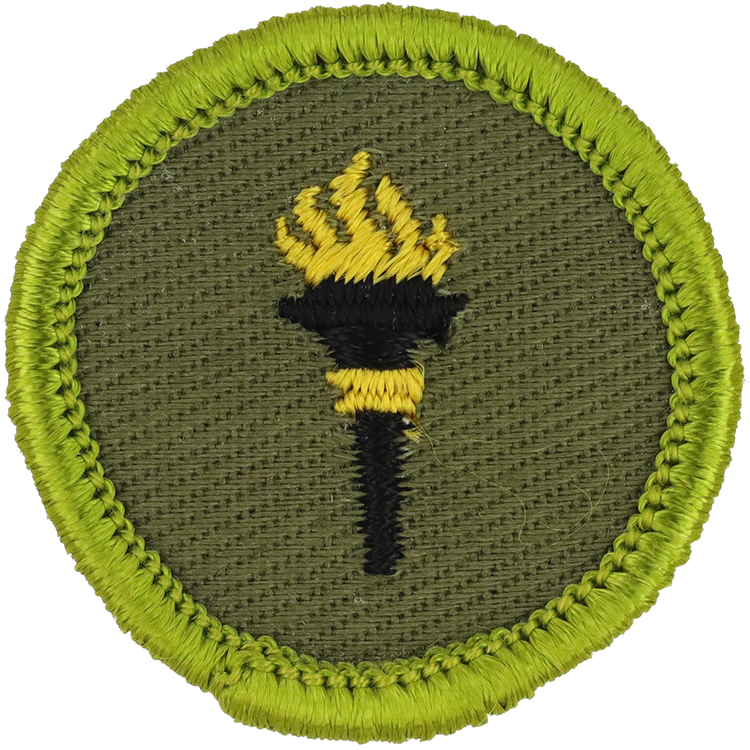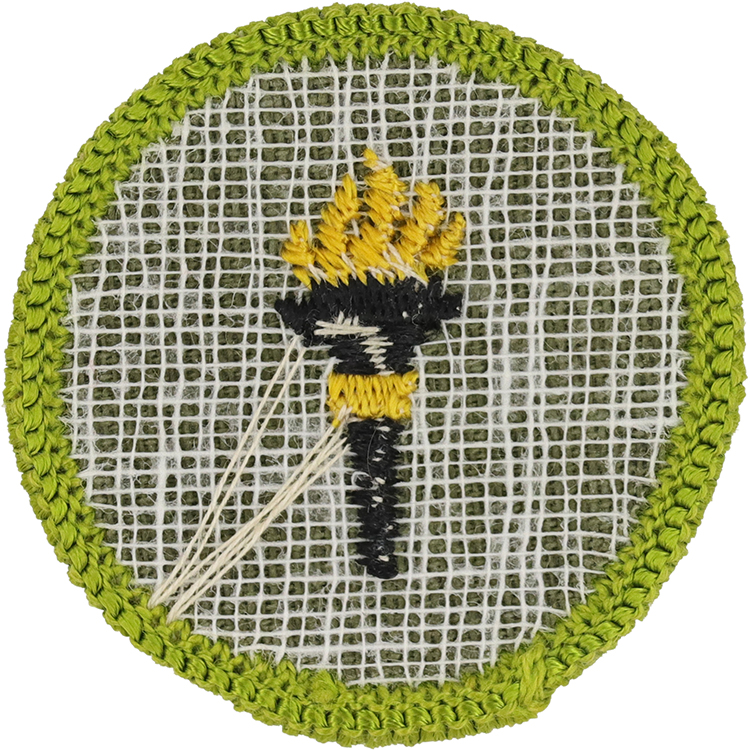
Fig. 1: PubHea-F-Front
- Cloth: Green right twill
- Border: Merrowed

Fig. 2: PubHea-F-Reverse
- Back: Gauze reinforced starched
Item Name: Public Health 1961 - 1968
Item ID: PubHea-F
Collector Rating: 1
Requirements January 1957 until September 1962
1. Tell how people contract five of the following diseases and what you and the health department can do to prevent their spread: typhoid fever, diphtheria, malaria, hookworm, Rocky Mountain spotted fever, tetanus (lockjaw), rabies, whooping cough, scarlet fever, tuberculosis, smallpox.
2. (a) Name two diseases common to animal and man that can be caught by a person through the drinking of unpasteurized milk. (b) Name two diseases that can be caught by drinking polluted water. (c) Name two diseases that can be spread by rats.
3. Explain how flies may be controlled and their breeding places destroyed.
4. Name three diseases against which an infant should be immunized and two diseases against which boys of Scout and Explorer age should be immunized.
5. Do two of the following: (a) Visit your state, county, or local health department and prepare an outline of its principal functions. (b) Visit your water treatment plant and prepare an outline of the major steps in the water treatment used to protect your community from diseases that may be spread by water. (c) Prepare a simple sketch of a home sewage disposal system and tell how it should be located and constructed to protect against the pollution of nearby wells or springs. (d) Visit a dairy farm and prepare an outline of the measures taken to produce clean milk for pasteurization. (e) Visit a milk pasteurization plant and prepare a brief statement on the pasteurization of milk. (f) Visit your community sewage treatment plant and prepare a brief statement about sewage disposal.
6. Do the following: (a) Filter one full canteen of muddy water, using clean cloth or other materials, and then make the water safe for drinking either by treatment with suitable chemical or by boiling water. (b) Dig and make ready for use either a straddle trench latrine or a "cathole" latrine; then fill in properly. (c) Properly dispose of garbage and rubbish from a camp site. (d) Describe how milk could be pasteurized in your home and make a quart of raw milk safe to drink.
7. Explain two purposes of the "recheck" examination given to Scouts by a medical doctor when they arrive at a council camp.
Requirements September 1962 until January 1969
1. Tell how people contract five of the following diseases and what you and the health department can do to prevent their spread: typhoid fever, diphtheria, malaria, hookworm, Rocky Mountain spotted fever, tetanus (lockjaw), rabies, whooping cough, scarlet fever, tuberculosis, smallpox.
2. (a) Name two diseases common to animal and man that can be caught by a person through the drinking of unpasteurized milk. (b) Name two diseases that can be caught by drinking polluted water. (c) Name two diseases that can be spread by rats.
3. Explain how flies may be controlled and their breeding places destroyed.
4. Name three diseases against which an infant should be immunized and two diseases against which boys of Scout and Explorer age should be immunized.
5. Do two of the following: (a) Visit your state, county, or local health department and prepare an outline of its principal functions. (b) Visit your water treatment plant and prepare an outline of the major steps in the water treatment used to protect your community from diseases that may be spread by water. (c) Prepare a simple sketch of a home sewage disposal system and tell how it should be located and constructed to protect against the pollution of nearby wells or springs. (d) Visit a dairy farm and prepare an outline of the measures taken to produce clean milk for pasteurization. (e) Visit a milk pasteurization plant and prepare a brief statement on the pasteurization of milk. (f) Visit your community sewage treatment plant and prepare a brief statement about sewage disposal.
6. Do the following: (a) Filter one full canteen of muddy water, using clean cloth or other materials, and then make the water safe for drinking either by treatment with suitable chemical or by boiling water. (b) Dig and make ready for use either a straddle trench latrine or a "cathole" latrine; then fill in properly. (c) Properly dispose of garbage and rubbish from a camp site. (d) Describe how milk could be pasteurized in your home and made safe to drink.
7. Explain two purposes of the "recheck" examination given to Scouts by a medical doctor when they arrive at a council camp.


